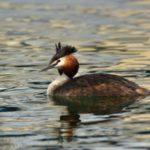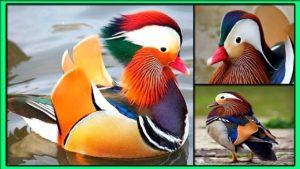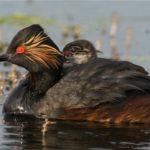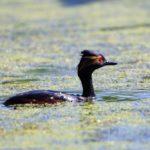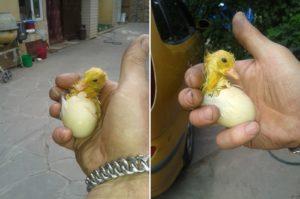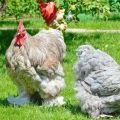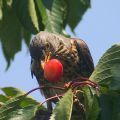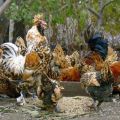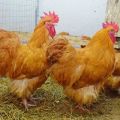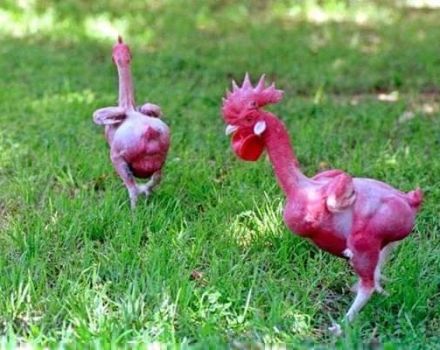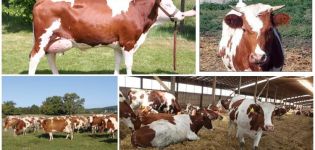Description and habitats of toadstool duck, wildlife behavior and diet
The duck, nicknamed the toadstool, actually has nothing to do with the order of duck, except for the similarity in appearance and constant living on the water. This bird in the common people is called the eared, crested, and scientifically - the great grebe or crested grebe. She was nicknamed toadstool for practically inedible meat - you can eat it, but it has a pronounced repulsive fish aroma.
Description of toadstool
The European grebe, or crested grebe, is the largest individual from the toadstool family and belongs to waterfowl. Outwardly, this bird resembles a duck, but the grebe and the duck have nothing in common. Due to the special structure of bones (they are not as hollow as in other birds, and less filled with air), toadstools can not stay on the surface of the water, but almost or completely immersed in it.
Crested Grebe appearance:
- the body is of a roll shape;
- thin, long neck;
- legs far back;
- almost invisible tail;
- flat claws;
- short wings;
- pointed straight beak.
A feature of the great toadstool is its legs - they are short but strong. They do not have membranes, like ducks, but there are wide blades on the sides of the fingers, with the help of which the bird quickly swims and dives perfectly. Three fingers are pointing forward, and the fourth is pointing back. During swimming, the legs are not under the body of the grebe, but behind, acting like a ship's propeller.
The toadstool has soft and dense plumage, feathers emerge from the skin almost at right angles. Outside the mating season, the male of the eared bird is difficult to distinguish from the female, both in size and in plumage - dark, gray colors prevail. In the mating season, tufts appear on the head and neck, the abdomen and neck are light in front, bright red feathers on the sides. A chestnut-red collar with a black border is visible on the neck. On the crown of the head there are 2 bunches of black feathers.
Bird habitat
The crested grebe spends most of its time on the water. Due to the special structure of the legs (they are located behind, there are no membranes on them), the bird walks with difficulty, looks awkward. Grebes rarely come ashore, mainly during the nesting period. They live in ponds and lakes.
Crested Grebe can be found on water bodies in any country of Eurasia. The bird does not like the cold climate, therefore it practically does not live in the northern regions. You cannot find the great grebe in Australia and New Zealand, they still live in Africa, although in small numbers.In central Europe, Grebe can live even in artificial reservoirs (ponds of city parks).
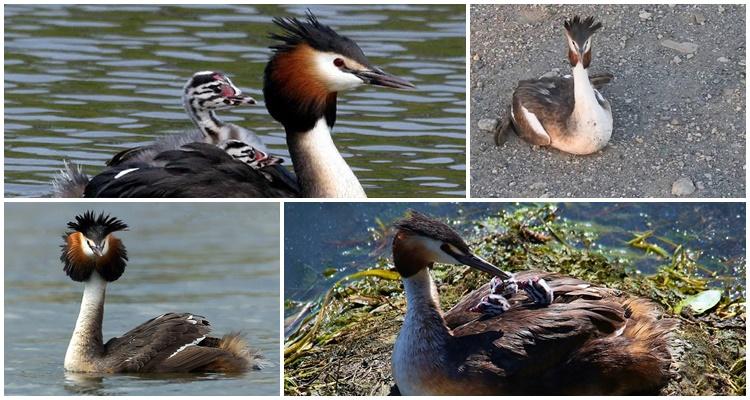
Behavior in the wild
Toadstool is a daytime bird, rarely moves at night and only when the moon is bright. Lives alone, creates a pair only during the nesting period. He is on the water all day long, dives perfectly, throwing himself into the water with his straight neck, swims under water for long distances.
The spring migration begins in March-April, when the reservoirs open. Grebes prefer nesting on lakes where there are areas of thickets and reeds, but there are also areas of open deep waters. If the reservoir is not large, Grebes nest in pairs. Large lakes can accommodate clusters of up to 50-100 pairs.
Diet
The main ration of the crested grebe is small fish, no more than 8 centimeters in length. Greater toadstool eats more fish than all other toadstool species.
In addition to small fish, it can eat:
- diving beetles;
- bugs;
- crustaceans;
- shellfish;
- dragonflies;
- water bugs;
- freckles;
- snails.
The main method of foraging for grebes is diving. They go under water 2-3 times a minute, each time covering a distance of up to 25 meters. One of 4-5 attempts to catch fish ends successfully. When an adult grebe catches fish, the ducklings rush to it with a squeak and try to get hold of food. Young animals are fed with tadpoles, small fish, insects.
A toadstool can spend hours on the surface of the water or, having submerged in it halfway, collect food from the water surface and catch insects on the fly.
Reproduction and mating season
Great Crested Grebes are known for their unusual mating games preceding nesting. From the outside, these games are similar to dance - birds swim towards each other, the plumage on the head is ruffled. Having met, the male and the female stand on the water, simultaneously dive and pick up algae particles from the bottom of the reservoir. They present them to each other in their beaks as gifts.
Both mating and nesting will take place on a makeshift raft of reeds and dried algae. But for mating, last year's raft is used, and for hatching the chicks, the couple jointly builds a new one. Eggs are usually laid at the end of May. The female lays 3-7 white eggs, but over time they acquire a brownish-green tint.
In a nest about 50 centimeters high, the eggs are kept warm, despite the fact that under the weight of the crested Grebe's body it sinks into the water. Both parents incubate. After 24-30 days, chicks hatch, already covered with fluff - the young have bright striped plumage. Chicks move to their parent's backs and stay there for up to 1.5-2 months, until they learn how to get their own food on their own.
Natural enemies
The main enemies that threaten toadstools, mainly during the mating season and during incubation of eggs, are:
- marsh harrier;
- gray magpie;
- magpie;
- pike.
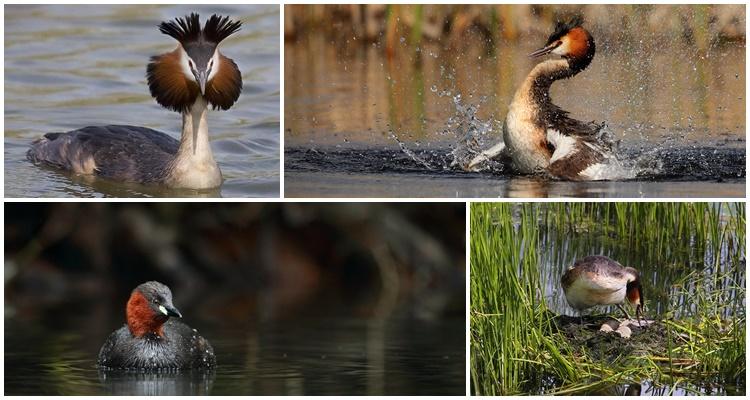
Birds can peck at a clutch of eggs, and pikes are happy to feast on young ducklings who are just learning to go down into the water. Toadstool can die in a fishing net if it gets entangled in it when it dives too deeply for food. Nests are threatened by extreme weather changes when strong waves rise and the water level in the reservoir rises.
Population and status of the species
Great crested Grebes belong to the species of grebes - a family of waterfowl. In total, there are 22 species in the population, 3 of which have already become extinct. Great crested Grebe is the most common toadstool bird species found in Europe. Grebes are not related to any bird species.Initially, it was believed that they belong to the family of loons due to external similarities and habits, later the theory was questioned. In 2003, the theory was voiced that toadstools are close relatives of flamingos.
In spite of the fact that many representatives of Greater Grepe die during hunting seasons (they shoot it along with the duck), under unfavorable climatic conditions, the population does not decrease. Over the past decades, there has been an increase in numbers due to the fact that the networks of fish farms and other artificial reservoirs are significantly expanding.


